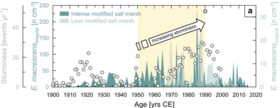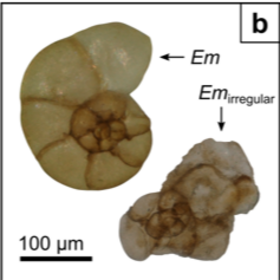Why more frequent storm surges stress salt marshes


Twentieth-century acceleration of global sea level and accompanying changes of storm-surge dynamics pose an increasing risk to cultivated and densely populated low-lying coastal areas. In this context, the SEASTORM project aims to investigate changes in the storm-climate conditions in the south-eastern North Sea region during the last century and their impact on the adjacent intertidal wetland ecosystems. These salt marshes are important because they can basically keep up with changing sea level through lateral and vertical growth and thus are important for natural coastal protection. However, salt marshes along the North Sea coast have been heavily altered by human activity over the past century through artificial drainage ditches, grazing and dike construction. It remains questionable if these human-altered salt marshes can adapt to storm surges under the influence of future sea-level rise.
To assess the resilience and sensitivity of salt marshes modified to different degrees by human interventions, two well-stratified sedimentary salt-marsh sequences were studied, including an un-grazed and more naturally developed salt marsh from the Bay of Tümlau and a grazed and frequently drained salt marsh from Friedrichskoog[1,2]. For assessing the stress on both salt-marsh ecosystems caused by a more frequent flooding, the occurrence of a benthic foraminiferal salt-marsh indicator species (Entzia macrescens) was evaluated, particularly considering the number of deformed specimens (i.e., E. macrescensirregular).
At both sites, highest numbers of E. macrescensirregular occurred at times when storminess and storm-surge frequency was likewise highest (Fig. 4a). It can therefore be assumed that a more frequent flooding of the salt marsh leads to increased environmental stress, to which E. macrescens reacts with test deformation (Fig. 4b). Stressful conditions are associated with increased salinity gradients on the salt-marsh surface and physical disturbances caused by frequent sediment re-deposition and increased turbulence during times of salt-marsh flooding. The number of deformed foraminiferal tests is comparatively lower in the Bay of Tümlau, while numbers are eight-times higher in the sedimentary sequence at Friedrichskoog. The contrasting numbers suggest that intensely human-altered salt-marsh ecosystems are more susceptible to frequent flooding and associated stress[2].
Read more in:
- Bunzel, D. et al. North Sea salt-marsh archives trace past storminess and climate variability. Glob. Planet. Change 198, 103403 (2021).
- Bunzel, D. et al. The response of human-modified coastal wetlands from the southeastern North Sea to amplified storm-climate conditions: indications by deformed marsh foraminifera. Ecol. Indic., under review.
